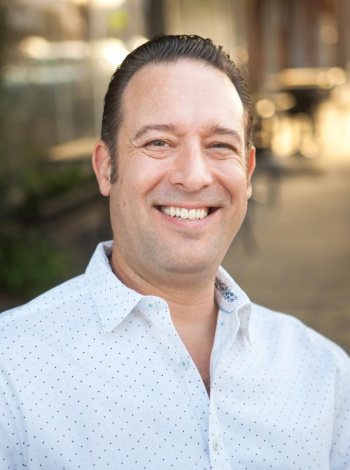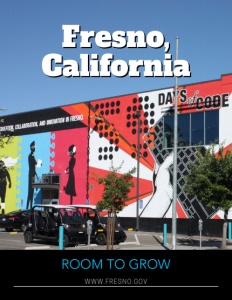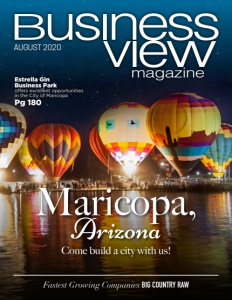Fresno, California
Room to grow
Business View Magazine interviews representatives from Fresno, California, as part of our focus on best business practices of American towns and cities.
Fresno is a city in, and the county seat of, Fresno County, California, located in the center of the San Joaquin Valley, which is the southern portion of California’s Central Valley. Named for the abundant ash trees lining the San Joaquin River, Fresno was founded in 1872 as a railway station of the Central Pacific Railroad before it was incorporated in 1885.
Today, the city of approximately 530,000 is an economic hub of Fresno County and the San Joaquin Valley, with much of the surrounding area predominantly tied to large-scale agricultural production. Major crops in Fresno County include grapes, almonds, cotton, peaches, and nectarines with combined annual sales in excess of $3 billion.
Fresno has had an ethnic mix from its earliest years with Chinese railroad workers and Scandinavian farmers joined by Germans from Russia, Japanese, and Armenians, and by the early 20th century, a large Hispanic population. There are now more than 70 ethnic groups in the metropolitan area.

Urban Planner, Dan Zack
For most of its history, this 112-square-mile city has grown from the center outward – its surrounding farmland continually giving way to more development. “The City of Fresno has for many, many years grown almost exclusively in an outward fashion with low-density, car-oriented neighborhoods at the edge of the city as our main form of growth,” notes Urban Planner Dan Zack. “And a lot of people prefer that kind of neighborhood, and that’s definitely part of our portfolio, but for a city as large as ours, with a population as varied as ours, we need to grow in more than one way. So, in 2014, we passed a new General Plan for the city – a 20-year vision for how we’re going to grow, and a new way of encouraging and regulating development to try and change the course of the city for the better.”
In order to carry out its vision, Fresno first reformed its entire zoning ordinance and zoning map. “That way,” says Zack, “investors, developers, and builders who want to come in and take advantage of these new regulations and the removed hurdles that previously existed for infill development, have a really easy go of it. They’ll find that projects that previously may not have been allowed, or may have been difficult, now, are relatively easy to do.”
Zack maintains that, as a business-friendly city, Fresno stands behind that bold statement with an innovative money-back guarantee. “We’re so confident in our ability to get plans approved quickly, that we’ll actually return application fees to applicants if we don’t have projects with all their final approvals within stated timelines,” he claims. “If someone comes in and proposes a project that’s consistent with the zoning, we’re not the type of community that will move the goalposts or require several public hearings and design review meetings. We have very clear, easy-to-follow standards, and if you meet them, you get a very quick approval. We have hit the one year mark without a single refund because everything has been processed within those stated timelines.”
A major priority of Fresno’s General Plan is to foster a better balance in the city’s growth. “The goal is for half of the future growth to continue to be in the conventional fashion on the outskirts of the city,” Zack explains. “We want to encourage the other half of our growth to go back into central areas, particularly downtown, a few key transit corridors, and other central neighborhoods, and we want to create more options for how folks can live. We want to create walkable environments at certain key nodes; areas where public transportation can really be effective and useful; and try to make a development pattern that’s as diverse as our population.”
“So ideally, folks who may be low income and need to be relieved of car expenses now can live by the BRT (Bus Rapid Transit) and take it to all the jobs downtown,” Zack continues. “And the younger, more cosmopolitan types of folks who want to have an urban lifestyle don’t have to move to Portland, New York, or Austin to get it. They can do it right here in Fresno. There’s a tech scene, a night life, and a brewery scene. So, it’s the kind of thing that’s good for our municipal budget and good for retaining young talent who want the urban lifestyle.”
“It’s good for our air quality too,” he adds. “Any person who chooses to live above a coffee shop downtown and walks or rides their bike everywhere isn’t driving a car and adding more to our air quality challenges. So, it’s the kind of thing we see as a win-win all around.
“The goal is to get 10,000 housing units into our downtown over the next couple of decades and another 10,000 on transportation corridors where we have enhanced bus service, and really focus some of our growth in these areas to offer some options to folks. Downtown is a little farther along than the transit corridors. In downtown, there have been about 600 apartments built, so far, by a variety of builders. We’re still in the early stages of it, but there are certain folks who are starting to dabble in that side of the market and, hopefully, they’ll continue to do so and we’ll see more and more success as time goes on.”

Economic Development Director, Lupe Perez
Lupe Perez, Fresno’s Economic Development Director adds that Governor Newsome recognizes the housing challenges in the State of California and particularly in the Central Valley. “He’s helping us to improve the housing and he’s committed money in the budget to help – about $20 million for education and housing. Having the support of the governor is tremendous,” she maintains.
“We’re a growth-friendly community so our housing challenges are a little bit different than, say, the Bay Area, where it’s really hard to get housing approved,” Zack says. “They build about one home for every eight jobs created in Silicon Valley. Here, we have the available land; we have regulations that are friendly to growth. We build a lot of homes, but we don’t always build the right kind of homes in the right places. With infill, some of the challenges are making the rent structure work to support the cost of new construction while still being affordable to local residents with lower incomes—it can be done, but it takes creativity. Luckily, though, we don’t have a strong anti-growth framework to contend with. It’s just a matter of making the numbers work and getting it done.”
Perez adds, “California, in general, is getting more and more expensive to live, but here in the Valley, it’s still reasonable to live here and have a good lifestyle and be able to afford a house and a car if you need one. And we can also offer a place downtown where you don’t need a car. So, I think we offer what other parts of our state generally look to. People don’t realize it’s here in the Valley, as well.”
Clair Whitmer is a strategy and operations expert at FUSE Corps, a national nonprofit that partners with local government to help urban communities thrive. She is also Fresno’s Opportunity Zone Liaison whose mission is to leverage the City’s portfolio of federal Opportunity Zones – each with its own needs and long-range planning strategy – to potential investors and developers. Opportunity Zones were created by the Tax Cuts and Jobs Act of 2017, allowing for certain investments in lower income areas to have tax advantages. To be nominated as an Opportunity Zone, a census tract must have a poverty rate of at least 20 percent, or a median family income not exceeding 80 percent of the statewide median family income. Fresno County has 47 such tracts, with about 38 of them in the city proper.

Strategy & Operations Expert, Clair Whitmer
“My purpose here, this year, is to get that effort started,” says Whitmer. “It’s really marketing, but it’s also telling Fresno’s story. We have project owners looking for investment and we have a list of investment funds that are looking for shovel-ready projects. We need to match-make between those two.”
Key to making a lasting match is aligning an investor’s plans with each particular Opportunity Zone’s needs, suitabilities, and advantages. For example, in Fresno’s Transit-Oriented Development Corridor Zone, the most suitable projects include: large retail, multi-family housing, mixed-use development, entertainment, medical research & clinical treatment, and small business. The Transform Fresno Hub is most suitable for commercial offices, multi-family housing, medical research, hospitality, food service, grocery and retail food, entertainment, and aviation. The Industrial Zone is best suited for fulfillment & logistics, transportation & warehousing, manufacturing, food processing, and renewable energy projects, and the East Fresno and West Fresno County Zones both favor food processing, renewable energy, sustainable agriculture, and resource conservation.
“The Fresno economy is more forward-looking than people may be imagining is happening here,” Whitmer notes. “And it aligns well with the industry that is already in place and reflects the energy and progressiveness that is already active here.”
Some of that progressive development activity has already taken place in Fresno. For example, Bitwise is a nascent tech company that offers technological education, collaboration, and local services to Fresno’s growing tech savvy community and businesses. “They’ve grown from 5,000 square feet to 250,000 square feet, downtown, in a combination of about four different buildings,” says Perez. “Recently, they partnered with Google to get additional funding and so they’re spreading their wings out to the valley – to the Bakersfield and Merced areas, as well. So, they’re really growing.”
Another local success story concerns Universal Meditech, a company that makes in-vitro diagnostic medical devices found in both hospitals and retail stores. Headquartered in the South Valley, Universal Meditech had determined that the space they were in was quickly becoming too expensive and wasn’t meeting their growing needs. The company began to look at options throughout the Valley and, with the help of the Fresno County Economic Development Corporation, determined that the options there, including lower land costs and access to a diverse pool of capable employees, were very appealing. Universal Meditech ultimately settled into a state-of-the-art, 20,000-sq.-ft. facility within the North Pointe Industrial Business Park.
Fortunately, Fresno still has the ability to grow outward should it ever need accommodate more homes and businesses. “Our city limits are about 112 square miles and we have a large perimeter area outside of that called the ‘sphere of influence.’ Those are areas that we ultimately plan to annex as the growth moves outward,” Zack explains. “We’re not like a lot of other cities our size, most of whom are hemmed in by multiple rings of other suburban municipalities. We have a lot of control of the rural edge of our metropolitan area, as well as the central part of our city, so we have a lot of room to not only infill but to grow outward, too. Whether it’s for single-family housing development or job-rich development such as industrial and distribution centers, there’s definitely room on our periphery that is available for us to annex and develop. We have a 50-50 plan: half inward growth and half perimeter growth, and whether it’s mixed-use infill or greenfield residential development, we’re ready for business.”
No one could have anticipated COVID-19, which sent cities across the country reeling from its economic impact. To help save local businesses, Fresno’s economic development teams are going into overdrive, identifying which businesses must close and when they can reopen, helping owners secure federal loans through the Payment Protection Program, obtaining personal protective equipment on behalf of businesses, tapping into federal funding available to city governments, spearheading recovery task forces and relief programs, and lifting up traumatized small business communities.
For a scrappy but burdened city like Fresno, access to federal funding from the U.S. Economic Development Administration, Environmental Protection Agency, U.S. Department of Housing and Urban Development, and the CARES Act can be the lifeline it has needed to give the city a leg up. Beyond the funding, Fresno now also enjoys a seat at the table, integrating with teams from the state and federal government in new ways. Beyond the funding, Fresno now also enjoys a seat at the table, integrating with teams from the state and federal government in new ways. The initiatives in place are collaborative, rooted in cross-sector partnerships, and cognizant of its history. Fresno innovates because its future depends on it.
AT A GLANCE
WHO: Fresno, California
WHAT: A city of 530,000
WHERE: In Fresno County, California, in the center of the San Joaquin Valley
WEBSITE: www.fresno.gov
PREFERRED VENDORS
Papé Kenworth, Papé Material Handling and Papé Machinery – Papekenworth.com | Papemh.com | Construction.papemachinery.com
Papé is the premiere capital equipment provider in the west. We are proud to partner with the City of Fresno.
Built for the long haul, our world class customers rely on Papé Kenworth’s fleet of trucks, stationed service teams, customer e-commerce portal and remote diagnostic technology to maximize your uptime. Papé Kenworth is here for you 24/7 and mile after mile with 23 locations along the I-5 corridor.
Papé Material Handling is your complete Hyster and material handling solutions provider. With an extensive new and used inventory and one of the largest rental fleets in the West, our team will help you find the right combination of equipment, storage, technology, automation and power to maximize your uptime.
“Rugged, reliable and ready to work, Papé Machinery Construction & Forestry has the ultimate support solutions to maximize your uptime on the construction site or in the forest. With versatile John Deere machines, varied inventory, JDLink, Topcon and drone technology, you can trust we have the right equipment to get the job done.
Call or visit your nearest Papé location to learn more.





